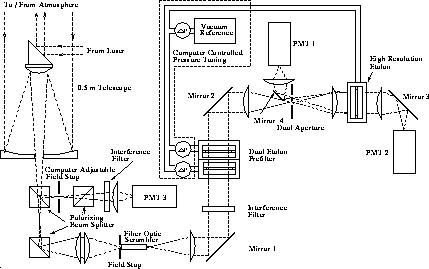



Next: A short introduction
Up: Introduction
Previous: Introduction
Return to the Publications.
Return to the Index.
In the earlier versions of the University of Wisconsin HSRL, the
separation between aerosol and molecular backscatter signals
was made with a high resolution etalon with  0.5 pm bandpass.
The Figure 3 shows the receiver of the etalon
based system [13].
The backscattered light
was collected by the receiver telescope and directed through
a fiber optics scrambler. The fiber optics scrambler was used to
reduce the range dependence of the receiver spectrometer bandpass
due to the angular sensitivity of the etalon transmission [12].
After collimation, the signal was prefiltered with an interference
filter and a pair of low resolution etalons. After passing the
dual aperture, the light was directed to the high resolution etalon.
The high resolution etalon was slightly tilted with respect to the
optical axis. This allowed the light that did not pass through the etalon
to be reflected back to the dual aperture and to the
molecular channel photodetector (PMT1). The light that passed through
the high resolution etalon was detected with the aerosol channel
photodetector (PMT2). The signal detected with the aerosol
channel was a combination of aerosol backscatter spectrum
and the center of molecular backscatter spectrum. The signal
detected with the molecular channel was a combination of
the wings of the molecular spectrum and the part of the aerosol
backscatter spectrum that did not pass the high resolution etalon.
0.5 pm bandpass.
The Figure 3 shows the receiver of the etalon
based system [13].
The backscattered light
was collected by the receiver telescope and directed through
a fiber optics scrambler. The fiber optics scrambler was used to
reduce the range dependence of the receiver spectrometer bandpass
due to the angular sensitivity of the etalon transmission [12].
After collimation, the signal was prefiltered with an interference
filter and a pair of low resolution etalons. After passing the
dual aperture, the light was directed to the high resolution etalon.
The high resolution etalon was slightly tilted with respect to the
optical axis. This allowed the light that did not pass through the etalon
to be reflected back to the dual aperture and to the
molecular channel photodetector (PMT1). The light that passed through
the high resolution etalon was detected with the aerosol channel
photodetector (PMT2). The signal detected with the aerosol
channel was a combination of aerosol backscatter spectrum
and the center of molecular backscatter spectrum. The signal
detected with the molecular channel was a combination of
the wings of the molecular spectrum and the part of the aerosol
backscatter spectrum that did not pass the high resolution etalon.

Figure 3: The receiver of the high resolution etalon based system.
The backscatter signal is collected with a telescope. The
fiber optics scrambler reduces the range dependence of the
receiver spectrometer bandpass due to the angular sensitivity
of the etalon transmission. The signal is background filtered
with a interference filter and a pair of low resolution etalons.
The separation between aerosol and molecular backscatter signals
is done in the high resolution etalon. The part of
the spectrum that transmits the etalon is combination of
aerosol backscatter spectrum
and the center of molecular backscatter spectrum (PMT2).
The signal detected with PMT1
is a combination of
the wings of the molecular spectrum and the part of the aerosol
backscatter spectrum that did not pass the high resolution etalon.




Next: A short introduction
Up: Introduction
Previous: Introduction
Return to the Publications.
Return to the Index.
Paivi Piironen
Tue Mar 26 20:49:55 CST 1996
 0.5 pm bandpass.
The Figure 3 shows the receiver of the etalon
based system [13].
The backscattered light
was collected by the receiver telescope and directed through
a fiber optics scrambler. The fiber optics scrambler was used to
reduce the range dependence of the receiver spectrometer bandpass
due to the angular sensitivity of the etalon transmission [12].
After collimation, the signal was prefiltered with an interference
filter and a pair of low resolution etalons. After passing the
dual aperture, the light was directed to the high resolution etalon.
The high resolution etalon was slightly tilted with respect to the
optical axis. This allowed the light that did not pass through the etalon
to be reflected back to the dual aperture and to the
molecular channel photodetector (PMT1). The light that passed through
the high resolution etalon was detected with the aerosol channel
photodetector (PMT2). The signal detected with the aerosol
channel was a combination of aerosol backscatter spectrum
and the center of molecular backscatter spectrum. The signal
detected with the molecular channel was a combination of
the wings of the molecular spectrum and the part of the aerosol
backscatter spectrum that did not pass the high resolution etalon.
0.5 pm bandpass.
The Figure 3 shows the receiver of the etalon
based system [13].
The backscattered light
was collected by the receiver telescope and directed through
a fiber optics scrambler. The fiber optics scrambler was used to
reduce the range dependence of the receiver spectrometer bandpass
due to the angular sensitivity of the etalon transmission [12].
After collimation, the signal was prefiltered with an interference
filter and a pair of low resolution etalons. After passing the
dual aperture, the light was directed to the high resolution etalon.
The high resolution etalon was slightly tilted with respect to the
optical axis. This allowed the light that did not pass through the etalon
to be reflected back to the dual aperture and to the
molecular channel photodetector (PMT1). The light that passed through
the high resolution etalon was detected with the aerosol channel
photodetector (PMT2). The signal detected with the aerosol
channel was a combination of aerosol backscatter spectrum
and the center of molecular backscatter spectrum. The signal
detected with the molecular channel was a combination of
the wings of the molecular spectrum and the part of the aerosol
backscatter spectrum that did not pass the high resolution etalon.




